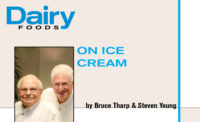

It’s “ice” cream for heaven’s sake — the only food designed, formulated, manufactured, stored, distributed, and sold with the express intent to be consumed frozen. It’s not frozen pizza, nor a pack of frozen peas. Ice cream is different.
For decades, a singular objective has been to raise the temperature at which ice cream and related products are made, stored, distributed, presented for sale, and consumed. This is not necessarily “new news.” The cost of the ice cream supply chain and environmental considerations (e.g., reduced “carbon footprint”) seem apparent and compelling.
However, frozen desserts are, inherently, different and typically distributed at -20 degrees Fahrenheit; presented for retail sale, and stored at home ( -5 F to - 10 F; perhaps as warm as 0 F.) To consider, frozen desserts as classical “frozen foods,” i.e., distributed at 0 F or above, presents significant technical challenges and a bit of re-engineering on multiple fronts, including the ultimate need to meet or exceed existing or new consumer expectations.
Mother Nature (i.e., the laws of chemistry and physics) dictates the amount, size, stability of “ice” particulates in ice cream, or any frozen dessert for that matter, at any given temperature (including the temperature of consumption). Critical, but, not the entire story, when delivering desirable and consistent eating qualities vis-á-vis any set of consumer expectations. Other important factors include mix composition, how the mix is prepared, stored, whipped/frozen, packaged, hardened, distributed, sold, and consumed.
Ultimately, the issue is melt behavior. There are three basic considerations involved relative to melt behavior of frozen desserts: (1) repeat transitions of ice-to-water-to-ice; (2) amount and rate of drip loss (actual loss of liquid water); and (3) loss and rate of loss of physical structure. We know the latter, as scoops of ice cream that retain their shape despite all the ice having been melted. Positive features for some; defects for others?
Factors influencing melt behavior include:
- Freezing profiling: Managing the amount of water frozen as ice at any given temperature below the freezing point of the mix.
- Water Control Index (WCI): Ability of mix components and the physical features of any given ice cream to interfere with the mobility of liquid water, yet, retain the number (more better than few) and size (small is better than large) of ice crystals.
- Fat Agglomeration Index (FAI): Ability to support structure via partial agglomeration of fat that can also interfere with water mobility.
- Mix Analytics: Such as amount/type total solids, fat, WCI, mix viscosity, FAI, relative sweetness, mix density, targeted finished weights (i.e., overrun).
- Mix Processing: Homogenization to create the maximum number of ultra-small fat droplets to yield optimum conditions for fat agglomeration during whipping/freezing in the barrel of the IC freezer and still have ice cream flow/behave as needed.
- Resistance to heat shock: Minimize the amount of ice that transitions, ice-to-water-to-ice; interfere with the mobility of liquid water at any temperature as to not interfere with body (bite/chew), texture (smoothness, creaminess), and, ultimately, flavor delivery.
- Packaging: Modification of size/materials? Why not? Remember, heat transfer “in” as packaged (i.e., heat shock) means same considerations related to heat transfer “out” (i.e., hardening.)
Now, consider qualitative influences on acceptability (i.e., “it’s flavor, stupid”). Remember, the perception of any flavor (F) is related to influences for good/bad as a complex combination of appearance (A; does the product look like what is being declared?), aroma (A; amount, type, quality of volatiles as any given ice cream is warmed during consumption); acidity (A: amount, type acids; understanding specific acids express “tartness” differently); taste (T: sweet, salty, bitter, sour, umami, “fatty”); texture (T: smooth/creamy; resistance to bite/chew); and temperature (T: too cold can be numbing; too warm be atypical). Easy to remember as F= AAATTT.
Sounds complicated, and it is, even for ice cream through ice cream distribution (-10 F to -20 F), storage for retail sale (-10 F to 0 F), and eventual consumption (0 F). All depends on factors as yet not fully leveraged nor leverageable nor even known.
Seeking the objective to distribute ice cream under “frozen food” conditions is not new. However, we know more and have more assets (ingredients, manufacturing hardware, mix analytics) to manage the challenges. This is certainly good news.
Less we forget, it’s important to consider products already accepted and sold in the marketplace. These now become “gold standards” that can be nearly impossible to match versus any change in the supply chain. This applies whether to a match of a competitive product or an in-house “control.” Given this, some degree(s) of variance from “normal” might be required, understood, and agreed upon.
So, what is/are the right thing(s) to do? When? Where? By how much? Standing in the way are Mother Nature’s rules of chemistry and physics. Does she know something we should know?



